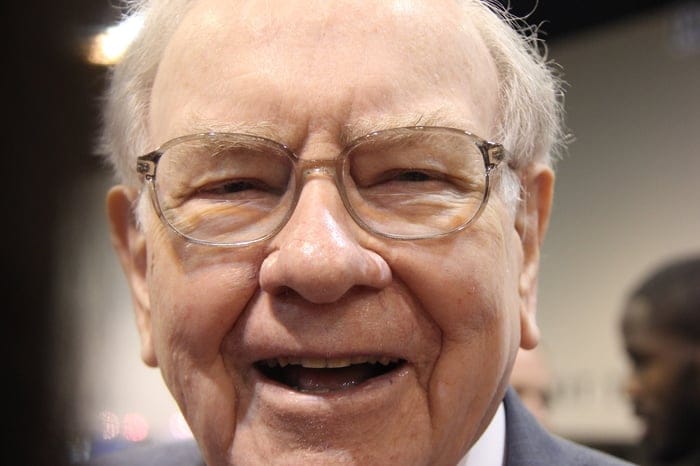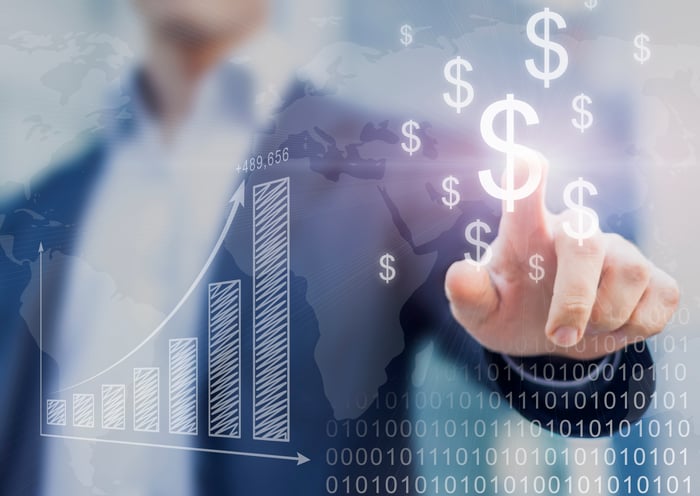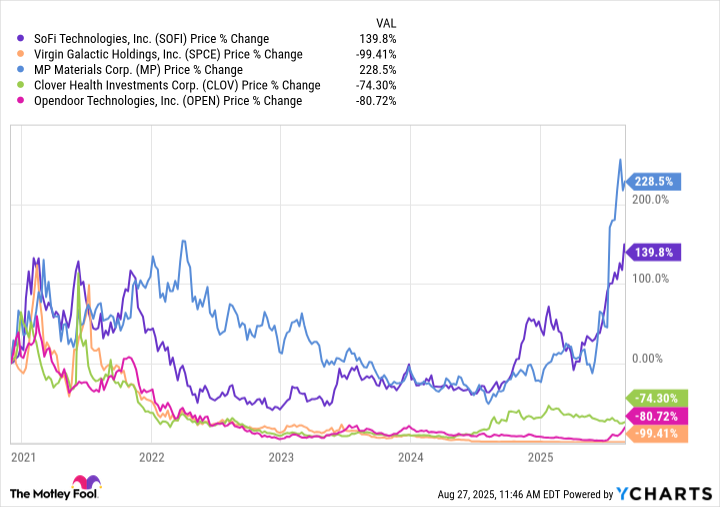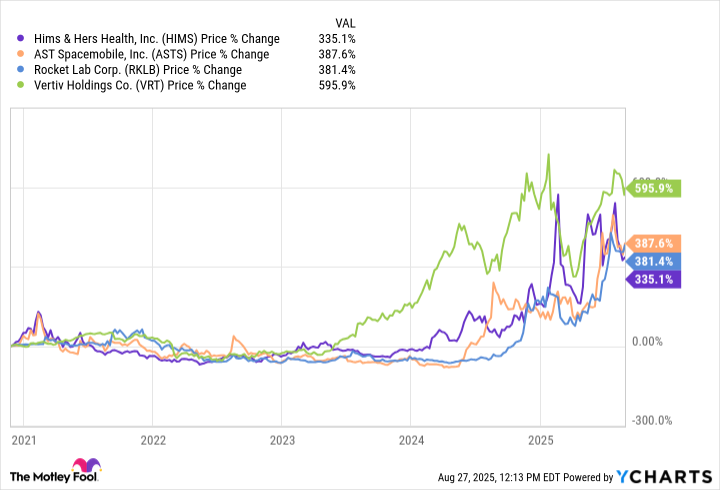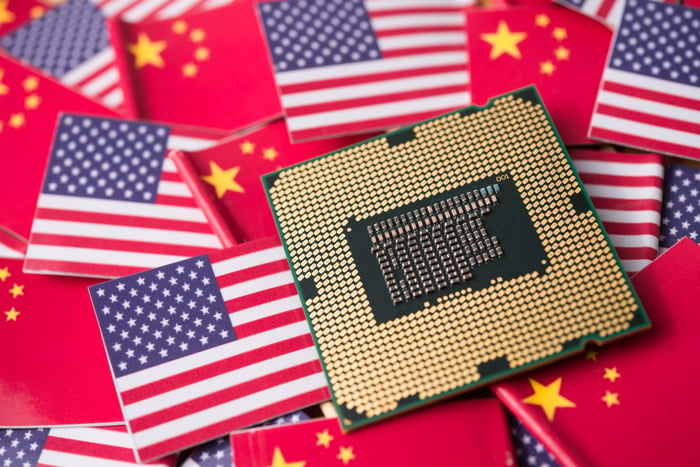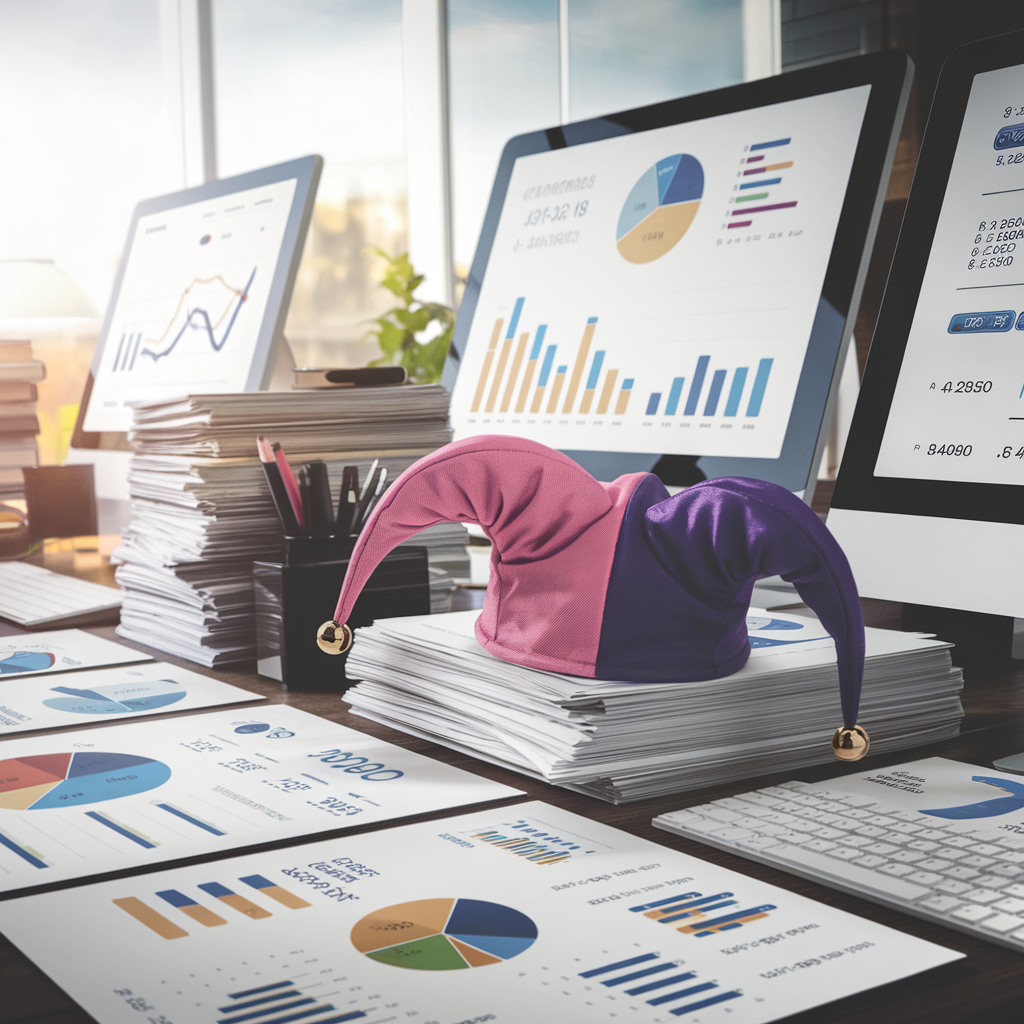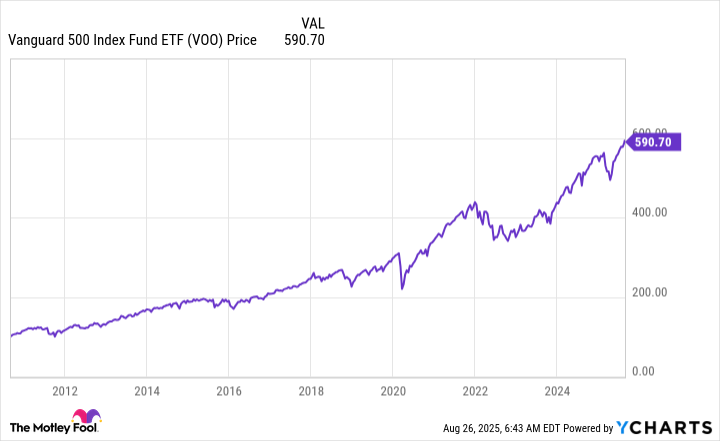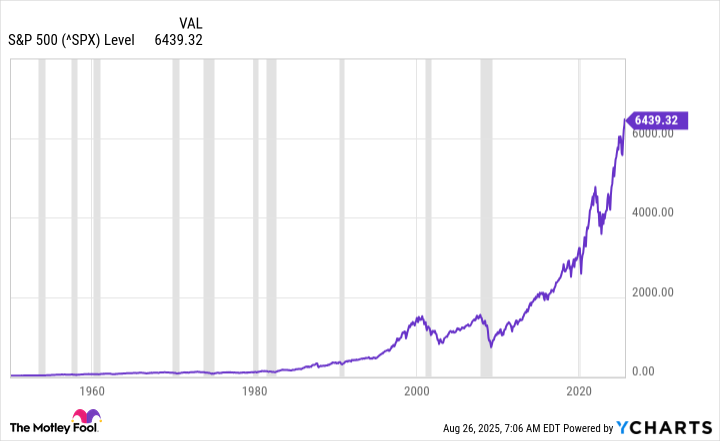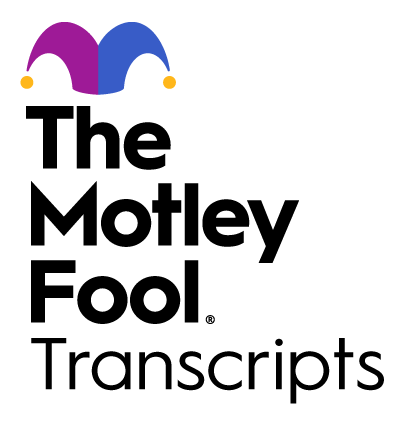
Image source: The Motley Fool.
Date
Aug. 28, 2025, at 9 a.m. ET
Call participants
- Chief Executive Officer — Todd Vasos
- Chief Financial Officer — Kelly Dilts
Need a quote from a Motley Fool analyst? Email [email protected]
Takeaways
- Net sales— $10.7 billion in net sales in the second quarter of fiscal 2025 (period ended Aug. 2, 2025), representing a 5.1% year-over-year increase.
- Same-store sales— Same-store sales increased 2.8% in Q2, with customer traffic up 1.5% and average basket size up 1.2%.
- Gross profit margin— Gross profit was 31.3% of sales in Q2 (up 137 basis points year over year), primarily driven by a 108 basis point improvement in shrink.
- SG&A as % of sales— 25.8% (up 121 basis points), mainly due to higher incentive compensation, repairs and maintenance, and benefits costs.
- Operating profit— Operating profit was $595 million (an increase of 8.3% year over year); margin rose 16 basis points to 5.6%.
- Net interest expense— Net interest expense was $57.7 million, down from $68.1 million in the prior year period.
- EPS— Diluted EPS (GAAP) was $1.86 per share in Q2, up 9.4% year over year and above the company’s internal expectations.
- Inventory— Merchandise inventories totaled $6.6 billion at the end of Q2, down $391 million (5.6%) overall and 7.4% per store.
- Cash flows from operations— $1.8 billion during the first half of the year, an increase of 9.8% compared to the prior year.
- Dividends— $0.59 per common share in the second quarter of fiscal 2025, with a total payout of approximately $130 million.
- Fiscal 2025 guidance— Net sales growth of 4.3%-4.8% expected for fiscal 2025, same-store sales growth of 2.1%-2.6% for the year, and diluted EPS (GAAP) of $5.08-$6.30.
- Capital expenditures— Planned $1.3 billion-$1.4 billion, including approximately 4,885 real estate projects, 575 new U.S. store openings, and up to 15 in Mexico.
- Store remodel activity— 729 Project Elevate remodels and 592 Project Renovate remodels completed in the second quarter of fiscal 2025.
- Delivery partnership expansion— DoorDash is available for 17,000 Dollar General stores, and Uber Eats works with 4,000 stores, with expectations to soon reach 14,000 stores.
- DG Delivery expansion– Management now expects to offer DG delivery for more than 16,000 stores by year’s end, compared to previous expectations of approximately 10,000 stores.
- DG Media Network— Retail media volume grew significantly year over year in the second quarter of fiscal 2025, supporting personalized customer engagement and partner ad spend.
- Non-consumable comps— Each major non-consumable category posted at least 2.5% same-store sales growth.
Summary
Dollar General(DG -2.10%) delivered sales and earnings growth above internal expectations in the second quarter of fiscal 2025, citing balanced performance across both consumable and non-consumable categories. Management committed to keeping more than 2,000 SKUs at a $1 or less price point, and highlighted that its $1 Value Valley assortment achieved same-store sales growth at more than double the total company rate in the second quarter of fiscal 2025. The company emphasized broad-based market share gains, expansion of delivery coverage to urban and rural stores, and successful shrink and inventory management as key drivers of financial improvement. Fiscal 2025 guidance was raised, and the company will redeem $600 million of senior notes early in the third quarter of fiscal 2025, using cash on hand, signaling a focus on improving balance sheet metrics.
- Todd Vasos noted, “To that end, we’re pleased to see growth with customers across all income brackets in [the second quarter of fiscal 2025]. This includes our core customer, who increased spending despite worsening sentiment. In addition, we continue to see trade-in growth with middle- and higher-income customers, which we believe is contributing to the strong performance in our non-consumable categories.”
- The company maintained that its price gaps remain within three to four percentage points of average mass retailers, underlining Dollar General’s positioning on everyday value.
- Dollar General’s initiatives in store remodels (Project Elevate and Renovate) are contributing to first-year annualized comp sales lifts in the range of 3%-8% for completed locations, based on the second quarter of fiscal 2025 results, with early customer satisfaction data described as significantly improved post-remodel, according to management commentary in the second quarter of fiscal 2025.
- DG Media Network is delivering incremental returns for partners seeking rural and lower-income customer reach, supported by proprietary customer data assets.
Industry glossary
- Project Elevate: Incremental remodel initiative targeting mature stores, focusing on merchandising optimization and physical investments to achieve 3%-5% first-year annualized comp sales lifts.
- Project Renovate: Traditional full remodel program targeting older stores, designed to deliver 6%-8% first-year annualized comp sales increases.
- DG Media Network: Dollar General’s retail media platform providing partners with retail ad space, audience data, and multichannel marketing access to Dollar General’s unique customer base.
- SKU: “Stock Keeping Unit”; a unique identifier for each distinct product carried for sales and inventory management.
- Value Valley: Merchandising set within Dollar General featuring rotating SKUs at the $1 price point, aimed at price-conscious customers.
Full Conference Call Transcript
Todd Vasos, our CEO, and Kelly Dilts, our CFO. Our earnings release issued today can be found on our website at investor.dollargeneral.com under News and Events. Let me caution you that today’s comments include forward-looking statements as defined in the Private Securities Litigation Reform Act of 1995, such as statements about our financial guidance, long-term financial framework, strategy, initiatives, plans, goals, priorities, opportunities, expectations, or beliefs about future matters and other statements that are not limited to historical fact. These statements are subject to risks and uncertainties that could cause actual results to differ materially from our expectations and projections.
These factors include, but are not limited to, those identified in our earnings release issued this morning under Risk Factors in our 2024 Form 10-K filed on March 21, 2025, and any later filed periodic report. In the comments that are made on this call, you should not unduly rely on forward-looking statements which speak only as of today’s date. Dollar General disclaims any obligation to update or revise any information discussed in this call unless required by law. At the end of our prepared remarks, we will open the call up for your questions. To allow us to address as many questions as possible in the queue, please limit yourself to one question.
Now it is my pleasure to turn the call over to Todd.
Todd Vasos: Thank you, Kevin, and welcome to everyone joining our call. I want to begin by thanking our team for their great work to fulfill our mission of serving others every day in our stores, distribution centers, private fleet, and store support center. These efforts are resonating with our customers as well as driving strong operating and financial performance. To that end, we are pleased to deliver strong second-quarter results highlighted by earnings growth that significantly exceeded our internal expectations. For today’s call, I’ll begin by recapping some of the highlights of our second-quarter performance as well as sharing our latest observations on the consumer environment.
After that, Kelly will share the details of our financial performance as well as our updated financial outlook for fiscal 2025. I will then wrap up the call with an update on some of our key growth-driving initiatives. Turning to our second-quarter performance, net sales increased 5.1% to $10.7 billion in Q2, compared to net sales of $10.2 billion in last year’s second quarter. This growth was driven by strong performance from new stores and our mature store base. We grew market share in both dollars and units highly consumable product sales once again during the quarter.
In addition to growing market share in non-consumable product sales, same-store sales increased 2.8% during the quarter driven by relatively balanced growth of 1.5% in customer traffic and 1.2% in average basket. The basket growth was driven by an increase in both average unit retail price per item and average items per basket. We were excited to see a second consecutive quarter of broad-based category growth with positive comp sales in each of our consumables, seasonal, home, and apparel categories. From a monthly cadence perspective, we saw same-store sales growth above 2% in all three periods, with our strongest comps in June and July.
We believe these strong and balanced top-line results are a reflection of the hard work the team has done to improve execution and further enhance the value and convenience proposition for both existing and new customers. To that end, we’re pleased to see growth with customers across all income brackets during the quarter. This includes our core customer, who increased spending despite worsening sentiment. In addition, we continue to see trade-in growth with middle and higher-income customers during the quarter, which we believe is contributing to the nice performance we’ve seen in our non-consumable categories. Ultimately, customers across all income brackets are coming to Dollar General as they seek value.
As America’s neighborhood general store in more than 20,000 locations across the country, we recognize and embrace our role in being here for what matters for our customers. This includes providing the items they want and need at prices they can afford. With that in mind, we are committed to delivering everyday low prices that are within three to four percentage points on average of mass retailers. While we are pleased that we continue to operate within the targeted price range, we are also focused on maintaining our substantial offering of more than 2,000 SKUs at or below the $1 price point.
We know this price point is important in helping our core customers stretch their dollar particularly at the end of the month and when budgets are tight. In fact, our $1 Value Valley merchandising set which is comprised of more than 500 rotating SKUs was one of our strongest performing areas in the quarter with same-store sales growth more than twice the rate of the overall company. We believe this holistic approach to offering value will continue to be important for our customers, particularly in the back half of this year. Now I’d like to provide a brief update on how we’re thinking about tariffs.
With the rates currently in place, we believe we will be able to mitigate the majority of the impact on our cost of goods. The proactive approach of our sourcing team coupled with our relatively low direct import exposure has positioned us well to serve our customers with a quality assortment at tremendous value. While the landscape remains dynamic, tariffs have begun to result in some price increases and we will continue to work to minimize them as much as possible. Most importantly, we know this further amplifies the need for value with our communities. And we remain committed to serving our customers with the everyday low prices they have come to know and appreciate from Dollar General.
Overall, we’re proud of our performance during the quarter and the tremendous progress we’ve made throughout the first half of the year. Our actions are delivering an enhanced shopping experience for our customers and driving strong operating and financial results. We are further strengthening our value and convenient proposition for our customers, while making significant progress on our long-term financial goals. Before I turn the call over for our financial update, I want to thank Kelly for her partnership. As well as her leadership of our financial organization over the last few years. We wish her the very best as she prepares and begins her new chapter.
I also want to note that we’re excited to welcome Donnie Lau back to Dollar General as our next CFO beginning in October. He is highly regarded throughout the organization for his deep understanding of the business, thoughtful strategic leadership, and appreciation for our culture and values. We look forward to his leadership of our financial organization as we seek to drive excellence and create long-term shareholder value. With that, I’d now like to turn the call over to Kelly.
Kelly Dilts: Thank you, Todd, and good morning, everyone. First, on a personal note, I wanted to express my appreciation to this team, our customers, and our shareholders. This is a special organization with a unique mission and I’m grateful for the time I’ve had to serve alongside them. Now that Todd has taken you through a few of the top-line highlights of the quarter, let me take you through some of the other important financial details. Unless we specifically note otherwise, all comparisons are year-over-year, all references to EPS refer to diluted earnings per share and all years noted refer to the corresponding fiscal year.
For Q2, gross profit as a percentage of sales was 31.3%, an increase of 137 basis points. This increase was primarily attributable to lower shrink higher inventory markups and lower inventory damages. Our focus on reducing shrink has continued to produce positive results. Including a healthy year-over-year improvement of 108 basis points in the second quarter. We’re excited to be outperforming the shrink reduction expectations contemplated within our long-term financial growth framework. In terms of both timing and magnitude. Given these results, we are optimistic about the potential for shrink reduction to contribute more than 80 basis points toward the operating margin goal of 6% to 7% contemplated within our long-term financial framework.
In addition, we were pleased to drive a reduction in damages in the second quarter as our efforts in this area have begun to take hold as well. The gross margin increase was partially offset by increased LIFO provision as well as increased markdowns and increased distribution cost. Now, let’s turn to SG and A. Which as a percentage of sales was 25.8%. An increase of 121 basis points. The primary expenses that were a higher percentage of net sales in the quarter were incentive compensation, repairs and maintenance, and benefits. Moving down the income statement, operating profit for the second quarter 8.3% to $595 million. As a percentage of sales, operating profit increased 16 basis points to 5.6%.
Net interest expense for the quarter decreased to $57.7 million compared to $68.1 million in last year’s second quarter. Our effective tax rate for the quarter was 23.5%, and compares to 22.3% in the second quarter last year. Finally, EPS for the quarter increased 9.4% to $1.86 which exceeded the high end of our internal expectations. Turning now to our balance sheet and cash flow, where we continue to make great strengthening our financial position. Merchandise inventories were $6.6 billion at the end of Q2, a decrease of $391 million or 5.6% compared to prior year. And a decrease of 7.4% on an average per store basis.
The team continues to do a tremendous job reducing inventory while increasing sales and improving in-stock levels which is having positive operational impact in both stores and distribution centers. The business generated cash flows from operations of $1.8 billion during the first half of the year an increase of 9.8% compared to the prior year. Our strong top and bottom line results along with our focused inventory management efforts continue to generate significant cash flow. During the quarter, we returned cash to shareholders through a quarterly dividend of $0.59 per common share outstanding for a total payment of approximately $130 million. Our capital allocation priorities continue to serve us well and remain unchanged.
Our first priority is investing in our business including our existing store base as well as high return growth opportunities. Such as new store expansions, remodels, and other strategic initiatives. Next, we seek to return cash to shareholders through a quarterly dividend payment and over time and when appropriate, share repurchases. And while our leverage ratio remains above our goal, which is below three times adjusted debt to adjusted EBITDAR, we are making great progress towards reaching our target level. Importantly, we remain focused on improving our debt metrics in support of our commitment to middle BBB ratings by S&P and Moody’s. Overall, we’re very pleased with our operating performance and financial results.
Our strong performance has positioned us to raise our financial outlook for 2025. This update primarily reflects our outperformance in the second quarter and improved outlook for the second half of the year. While considering the potential uncertainty, particularly on consumer behavior as we move through 2025. With that in mind, we now expect the following for 2025. Net sales growth of approximately 4.3% to 4.8% same-store sales growth of approximately 2.1% to 2.6% and EPS in the range of $5.08 to $6.30. Our EPS guidance continues to assume an effective tax rate of approximately 23.5% and that we will not repurchase shares under our share repurchase program. Now I want to provide some additional context around our expectations.
While we’re not providing specific quarterly guidance, the low end of our sales and earnings guidance ranges allow for increasing pressure on consumer spending as we move through the back half of the year with Q4 potentially more than Q3. In addition, we expect shrink to be a continued tailwind throughout the remainder of the year, though to a lesser extent in Q4 as we begin to lap the improvements we made toward the end of last year. Turning to SG and A, given our strong performance we now anticipate incentive compensation expense to be a headwind of approximately $200 million.
Moving to the final portions of our guidance for 2025, we continue to expect capital spending in the range of $1.3 billion to $1.4 billion designed to support our ongoing growth. This includes our continued expectations to execute approximately 4,885 real estate projects in 2025 including 575 new store openings in The United States and up to 15 in Mexico. 2,000 project renovate remodels 2,250 project elevate remodels, and 45 relocations. Finally, as a result of our strong cash position, we are using cash on hand to redeem $600 million of our senior notes in the third quarter, earlier than their April 2027 maturity.
In summary, we’re pleased with our Q2 results, and we’re proud of the work that the team has done to strengthen our operating and financial position. This business model is strong and we believe Dollar General is well positioned to drive sustainable long-term growth on both the top and bottom lines while creating long-term shareholder value. With that, I’ll turn the call back over to Todd.
Todd Vasos: Thank you, Kelly. I’ll take the next few minutes to provide updates on three of the most important initiatives across the business. As we look to further advance our progress toward achieving our short and long-term goals. I’ll start with our real estate work. As we continue to focus on driving sales and market share growth by expanding our unique real estate footprint while also enhancing our mature store base. We opened 204 new stores in Q2, primarily using our 8,500 square foot format in rural markets. Dollar General continues to serve as a vital partner, bringing value and convenience to communities across the country through new store growth.
In addition to our US growth, we opened four new stores in Mexico during the quarter, bringing us to a total of 13. Our team is doing a wonderful job serving those communities as we continue to test and learn and further develop that potential growth opportunity. We are also pleased with the progress of our remodel projects, As a reminder, in addition to our traditional remodel program, which we call Project Renovate, we have introduced a new incremental remodel program called project elevate in 2025. This initiative is designed to drive sales and market share growth in portions of our mature store base that are not yet old enough to be part of a full remodel pipeline.
These projects include physical asset investments as well as merchandising optimization, product adjacency adjustments, and category refreshes, all of which impacts approximately 80% of the total store. We completed 729 project elevate remodels in Q2 and an additional 592 project renovate remodels during the quarter. While still early, we expect to reach our goal of delivering first-year annualized comp sales lifts in the range of 6% to 8% for project renovate stores and three to 5% for project elevate stores. Importantly, we’ve seen significant improvements in customer satisfaction in these locations upon completion of the remodels.
And we believe the improved performance and customer response in these stores paves the way to make Project Elevate a key component of our real estate strategy in the years ahead. The next area I want to discuss is our digital initiative. Which serves as an important complement to our expansive store footprint as we continue to deploy and leverage technology to further enhance convenience and access for our customers. Our digital capabilities include an engaging mobile app and website that continues to be very popular with our customers as well as growing our delivery options and DG media net. We continue to expand the reach of our delivery options with solutions targeted both new and existing customers.
Our DoorDash partnership, now serves more than 17,000 stores, continues to drive significant incrementality and sales growth. To that end, our Q2 sales through this platform increased by more than 60% year over year. Building on this success, we partnered with DoorDash to launch our own same-day delivery offering through our DG digital solutions late in 2024. We have now expanded this offering to nearly 6,000 stores. We are also excited to note that we now expect to offer DG delivery for more than 16,000 stores by year’s end. Compared to our previous expectation of approximately 10,000 stores.
And most recently, we entered a partnership with Uber Eats to further expand the reach of our delivery capabilities as we provide value and convenience to customers on their platform. We have already expanded to approximately 4,000 stores with Uber and expect to be in approximately 14,000 stores by the ‘3. Collectively, more than 75% of the orders through these offerings are delivered in one hour or less. Ultimately, we believe this suite of delivery options will introduce new customers to Dollar General and drive incremental sales growth while also further enhancing the value and convenient proposition for our existing customer base.
The linchpin of our digital initiative is our DG media network, which enables a more personalized experience for a unique customer base while delivering a higher return on ad spend for our partners. We continue to be pleased with the performance of DG Media Network. Which is driving significant year-over-year growth in retail media volume as partners seek to access our unique customer base.
This initiative is an important component of our strategy to deliver on our long-term growth framework and we are excited about its Over time, we believe we can leverage our digital initiative to increase market share and drive profitable sales growth while further evolving our relationship with our customers and driving greater customer loyalty within the digital platform. The final initiative I want to discuss is our non-consumables growth strategy. As a reminder, we are focused on a few key growth drivers in our non-consumable categories over the next three years. These include brand partnerships, a revamped treasure hunt experience, and reallocation of space within our home category.
During Q2, we were pleased to deliver positive quarterly same-store sales growth in each of the three non-consumable categories for the second consecutive quarter. Notably, the magnitude of growth was broad-based with same-store sales increases in each of these categories of at least two and a half percent. Our brand partnerships are resonating with customers, and we have been pleased with the strong sell-through in many of these sets. As a result of the success, as well as our improved execution, our home products category saw its largest quarterly same-store sales increase in more than four years. In addition, our pop shelf stores delivered another quarter of strong same-store sales growth.
We continue to be pleased with the performance of the new store layout in this banner including a greater emphasis on categories such as toys, party, candy, and beauty. The pop shelf banner also continues to produce learnings that we are able to apply to our non-consumable categories in our Dollar General stores to further strengthen that offering for our DG customers. We believe our non-consumable sales performance both in Dollar General and Popshelf stores also benefited from improved execution in our stores and supply chain. As well as from the expanded trade in shopping we’ve seen from middle and higher-income customers.
These results, strong sales performance and market share gains continue to demonstrate that our treasure hunt approach is resonating with the customer. In turn, we believe we are well-positioned to serve them in these discretionary categories in stores across both banners and ultimately drive further growth in both sales and gross margin. In closing, we’re pleased with our second-quarter performance. Operationally, we are improving execution stabilizing our workforce through lower turnover rates, advancing our key initiatives, and enhancing our position for sustainable long-term growth. Financially, we’re delivering balanced sales growth significant margin improvement, and strong earnings, while also strengthening our balance sheet and operating cash flow.
With that said, we have ample opportunity in front of us to drive growth and further improve our operating and financial performance. And this team is laser-focused on delivering on these goals. As an essential partner in communities across the country, our customers rely on Dollar General in all economic environments. Delivering on our mission of serving others continues to guide everything we do, and we are excited about our plans for the back 2025 and beyond. Lastly, I want to thank our more than 195,000 employees for their commitment and dedication. And I’m looking forward to all we can accomplish together in the second half of the year.
With that operator, we would now like to open the lines for questions.
Operator: Thank you. At this time, we’ll be conducting a question and answer session. If you like to ask a question, please press star 1 from your telephone keypad, a confirmation tone will indicate your line is in the question queue. May press star 2 if you’d like to remove your question from the queue. For participants using speaker equipment, it may be necessary to pick up the handset before pressing the star keys. We may address questions for as many participants as possible, ask you to please limit yourself to one question. One moment please for our first question. And the first question is from the line of Michael Lasser with UBS. Please proceed with your question.
Michael Lasser: Good morning. Thank you so much for taking my question. Given that you are optimistic that shrink could contribute more than 80 basis points to your long-term financial framework. Does that mean that you expect to be able to realize the six to 7% operating margin maybe as soon as next year, or, alternatively, your long-term range should be recalibrated above 7%, or are you seeing anything in the environment that might suggest you’ll have to take some of this upside and shrink and other factors and reinvest it back in the business in order to drive the top line. Thank you so much.
Kelly Dilts: Yeah. Thank you, Michael. Great question. So we are definitely optimistic that we could potentially outperform on shrink and get a little bit more than 80 basis points over the mid to longer term. But we’re still targeting that long-term framework of 6% to 7% on the operating margin. This quarter just solidifies the fact that we feel good about where we are. Shrink is a big component of that and we’ve got a lot of strategies and initiatives in place to achieving that long-term framework. I think what’s important for us is not only getting to that 6% to 7%, but also the sustainability of that operating margin as we go forward.
Operator: The next question is from the line of Simeon Gutman with Morgan Stanley. Please proceed with your question.
Simeon Gutman: Hey. Good morning, everyone. And, Kelly, good working with you, and then eventually, congratulations to Donnie. I’m gonna ask you a two-part you’re welcome. Two-part question. So first, if you take the gross margin in the second quarter, and we hold that base, it does look like it steps down in Q3, but is there any reason why it should step down more than expected seasonally? Meaning, is there anything temporal about the gross margin that’s not a good proxy? And then second, Todd, from when you came back in 2023, thinking about all the execution items, can you talk about what’s left and what you’ve gotten done? Thanks.
Kelly Dilts: Yes. So I’ll answer the gross margin question first. What we’re seeing now is obviously just an outperformance on shrink. So 108 basis points this quarter of the 137 basis points improvement. As we think about cadence for the back half, we’re certainly expecting a year-over-year improvement in both of the quarters. But what I would tell you is we actually have tougher laps in Q4 on the gross margin front. And so we would expect maybe a little bit less on Q4 as far as improvement over year-over-year. And then you didn’t ask about SG and A, but I do want to call out just one thing on the SG and A front.
We would expect more pressure in SG and A in the third quarter, and that’s really around repairs and maintenance. It’s kind of the season for repairs and maintenance we get into hurricane season and we’re still kind of in that warm weather. But what’s the big contributor there is we’re also wrapping up our project Elevate and Renovate. Projects mostly in the third quarter, and so that puts a little bit of pressure on Q3.
Todd Vasos: Yes. And Simeon, I am very, very pleased with where we are, with our back-to-basics work. I would tell you that the team has done a really good job from, back of house. So our supply chain, our merchants, to front of house, if you will, and that’s in our stores and the execution. It really is paying off. You can see it in our top line. Not only a strong 2.8% comparable sales number that we posted, but as you look at that sales number, it’s very balanced. Consumables and non-consumables contributed very nicely to that 2.8%. I would tell you that we are retailers.
We always have work to do as it relates to a lot of what we’ve been working on. But, again, if I was to step back and think about it and base terms and innings, I would say we’re in the very late innings of this game. And then we’re really into now sustainability. Of what we have worked on. And I would tell you, feel real good about that as well. From a couple standpoints. Number one, we have done a really nice job in our turnover rates have come down. We’ve had some consecutive quarters of those decreases and we continue to be happy with where we’re at.
I would tell you that our pipeline for folks coming into the organization is as robust as ever. And I’m very happy to say that our store manager turnover rates are down again this quarter. So a lot of what we’ve been working on to make life easier at the store level is starting to really resonate not only with the customer, but our employee base, which is really important.
Operator: Our next question is from the line of Rupesh Parikh with Oppenheimer. Please proceed with your question.
Rupesh Parikh: Good morning, and thanks for taking my question. And also, Kelly, best of luck. So I’m gonna focus my comments just on delivery. So as you look at the DoorDash and I guess Uber is still very early, but just any surprises or key learnings to date? And then, you know, as you’ve added Uber, like, how do you think about the incrementality of that offering? Thank you.
Todd Vasos: Yeah. Rupesh, thank you. Yeah. I can tell you, our digital solutions in general, just totality, we’re very happy with where we are. Very early innings. Again, baseball analogy for you. Very early innings on our digital journey. But as you know, and you’ve pointed out, DoorDash has been really the start of our digital journey, if you will, from a delivery perspective. We’re up to 17,000 locations which is great to see. And I would tell you that we saw a 60% year-over-year increase on that platform. And by the way, off of a pretty robust number to start with. So very happy with what we’re seeing there.
But the team isn’t slowing down here because again, we’re in the early innings. Saw where we just signed a deal with Uber Eats. We are happy with what we are seeing very early there in the partnership. 4,000 stores up and running. And by the end of the third quarter, we’ll have 14 stores is what our goal to have up and running on that platform. And that just expands the reach to our to our consumer. And then last lastly, on our delivery piece, white label program that we stood up Again, very early days, but we’re seeing both incrementality there as well as larger bass baskets.
And these larger baskets and some of them well north of $20 baskets for us would point to incremental ality and would point to more of a fill up versus a fill in. With that notion, you would feel that and we feel that a lot of it is incremental to our base. The great thing about our delivery piece is we are going to have more and more stores up and running. Believe we were great to be able to put out there 16,000 by year end now. Which is an acceleration from where we were. And I think that’s a real testament to what we’ve already seen so far.
You know, to use my terminology, we’re gonna put the pedal to the metal here. Because we see some real opportunity ahead. And I would tell you again the platform across all the digital properties The linchpin of this is our digital media network. And again, it has shown strong results this quarter. And continues to show strong results. So stay tuned there because I believe there’s going to be even more incrementality that comes from that media network. We have a very unique customer base, as you know, being that 80% of our stores are in small town rural America.
And it is hard for CPG companies and other companies to get ahold of clientele that is just in those areas and we have all that data. And so that data will be used in our media network. And I would tell you that our partners already very interested in that. And then lastly, our secret sauce here, if you will, is that so far to date, we have seen that 75% plus of our deliveries are in one hour or less. And I would tell you that is the fastest that we’ve seen out there across the spectrum so far. Rural America where it is hard to reach many, many customers.
So, we believe that’s a competitive advantage for us. And will continue to be as we move forward.
Operator: Our new question is from the line of Matthew Boss with JPMorgan. Please proceed with your question.
Matthew Boss: Thanks and congrats on a nice quarter. So Todd, on your forecast for increasing pressure, on the low-income consumer as the year progresses, what are you seeing in your survey work today across your income, customer cohorts? And where do you see DG’s value proposition as it stands today relative to opportunities maybe planned to amplify value? And Kelly, on the gross margin, where do you see shrink recovery in terms of innings today? And how best to think about additional drivers of gross margin multiyear from here?
Todd Vasos: Yeah. I’ll start, Kelly, and, send it over to you. You know, right now, Matt, I would tell you that, I would characterize the number one as resilient. And number two, seeking value. And seeking value we’re seeing that in all cohorts of customer, meaning our core customer, mid and high-end customers, all seeking value at this point. We’re seeing in our numbers, our trade-in has been accelerating over the last few quarters. We saw that again And what we’re seeing from the customer You know, coming into and out of Q2. is a good start to Q3. Our back-to-school offering was solid and in good shape.
And I would tell you our harvest and Halloween programs are off to a great start. It really shows and what we see in our data is not only our existing customers, but those new customers coming in. And those new customers coming in have a little extra money in their pocket to spend on that non-consumable categories. And as you heard in my prepared remarks, and I mentioned earlier, we saw a really nice balance in our sales of both consumables and non-consumables. But I would tell you, it’s it’s much deeper than that as well. As they seek value, we have a great proposition for them. Right?
So our everyday low price stance, we have never lost focus on that. We’re as good as ever across all classes of trade on our everyday price, and our customers resonate with that very nicely. We have a great promotional cadence that we use. To continue to stimulate that consumer and especially stimulate these newer consumers as they come in to, to deliver value because they’re not as familiar with that value proposition and what we offer them. So that digital through digital properties, we’re able to reach them. And, so a nice promotional cadence in as well.
Here’s the other value proposition that I think gets lost at times, and that is we still have and will continue to have at least 2,000 items at a dollar or less every day on the shelf. Matter of fact, our Value Valley area, which I know you know, Matt, pretty well, we have over 500 SKUs, and they’re rotating SKUs. At that $1 price point still today. With 2,000 overall inside the store. And I would tell you in Value and across the store, the gross margin on those items are it may exceed the category margins in each one of those items that they play in. So it’s very sustainable for us.
And by the way, when you look across the retail spectrum, it’s a very elusive price point at this point. I would say we’re one of the only ones that have really doubled down here and really pushed that $1 price point. So value to me, and I believe as our consumers look at it, is multi-pronged here at Dollar General and is very sustainable.
Kelly Dilts: On the gross margin side, take it in a couple of pieces. So first on the shrink side, again, we were just really excited to be outperforming the shrink reduction that we contemplated in our long-term framework again and timing and magnitude. Shrink continues to build then the trend and like I talked to earlier, we do anticipate it’s going to continue to be a tailwind. Into 2025 even with the tougher lap in the second half and particularly in Q4. If you don’t mind, I’m just going to list out all the actions that we’re taking because as you know, we’ve got a full team that sits on this shrink problem and they are really producing it results.
The first thing was just the self-checkout conversion and that’s been a big tailwind. But we’re also getting back to our operational excellence with strong in-store control environments and we see that because we continue to see shrink improvement in stores that never had self-checkout. And so that’s great to see. All the inventory reduction and SKU rationalization work is contributing. The improving retail turnover that you heard us talk about is certainly a contributor to this as well as just the expanded shrink incentive programs that we put in place.
We’re still utilizing the high shrink planograms Then as you know, we really worked at this end-to-end process in so that we make sure that we’re mitigating shrink at all points of exposure. I think what all of this combined gets us really excited because there’s as you can remember, it takes a full year for benefits of any actions to truly show up in the P and L. And our workaround shrink never ends, as we add continual actions, we should see some improvement.
So over the mid to long term, we do feel optimistic that we would give it more than the 80 basis points of shrink improvement I think the other piece that we’ve talked about in the long-term framework and that we’re starting to see improve is also around damages. So our goal going into 2025 for damages was flat to slightly favorable. We’re still holding that in the back half but I’ll tell you that Q2 exceeded our expectations and as you saw, it was actually a call out of the good guy in our variance analysis in our earnings release.
So really pleased to see that starting to take hold and just like shrink, we’ve got a team after this A lot of the things that help us on the shrink side also help us on the damage side, which is the inventory reduction, SKU rationalization. We’re also having a full court effort around product rotation, getting more precise in our inventory allocation, which helps us to mitigate future expiration damages. Then just that proactive investment in the repairs and maintenance through our two remodel programs should also help us reduce cooler damages.
So I would tell you between the two overall, we are just feeling really good about the path to improvement, that 80 basis point on shrink, the 40 basis points on damages that we identified in our framework that we rolled out in March. And then just on the initiative side, think you’ve heard Todd talk all about the initiatives that we have in place to drive their 150 basis points around DG media network, all the exciting things that we’re doing with delivery and the non-consumable as well. So we feel good about gross margin as we head into that mid and longer term.
Operator: Our next question is from the line of Edward Kelly with Wells Fargo. Please proceed with your question.
Edward Kelly: Hi. Good morning, everyone. Thank you for taking my question. I wanted to follow-up on the gross margin. Obviously, a very strong result this quarter, shrank a big driver. You know, but LIFO was an offset, and it does seem like there’s I don’t know, roughly, like, 80 basis points in here of, you know, a tailwind that I mean, I guess, it seems like a lot of it is initial markup. So can you just talk about, you know, what that is? And then just a quick follow-up. SG and A, you know, there has been some talking about increased higher liability claims.
Just kinda curious, is that something that are seeing, sort of like where you are in the process there, from, an actuarial standpoint in assessment, and if there’s any risk there. Thanks.
Kelly Dilts: Yeah, thank you for the question. So, yeah, on the LIFO, would say, you know, year to date Q2 reflects what we know as regards to current tariff rates as well as it contemplates any cost increases that we’ve gotten from any of our vendors. If you step back and just take a look at the big picture what I would say is of the 137 basis points improvement in gross margin, we got 108 basis points of that in shrink. And then we’re getting 29 basis points tailwind from all of the other areas combined. Solid improvement on the gross margin front.
Todd Vasos: You to address workers’ comp and those people?
Kelly Dilts: Yeah. Thank you, Todd. And then on the general liability front, we are seeing some impact. It’s not material. Generally, we’re seeing the trend towards claims being more expensive as resolve those, but not material impact to us right now. Trends that we are seeing has certainly been contemplated in our guidance.
Operator: Our next question is from the line of Zihan Ma with Bernstein. Please proceed with your question.
Zihan Ma: Great. Thank you so much for taking my question. I wanted to break down the comp sales performance a bit more. In terms of, you mentioned, the trade-in benefit and also, of course, the better store operations driving more traffic. Can you help us better understand what proportion of the comp is driven by more macro-oriented trade-in versus more company-specific? And then going into next year as we start to lap the tougher trading comps, what is going to be sustainable on the top line? Thank you.
Todd Vasos: Yeah. Well, I would think as we look at where we are today, let me address the first part. And then we’ll get to that sustainability piece. We feel good about where we are both from our core consumer as well as the trade-in consumer. And I would tell you that a lot of the work that we did Back to Basics has served us well. And, quite frankly, has set us up nicely for that trade-in consumer. As that trade-in consumer came into the brand, over the last few quarters, they’ve seen a better store both from cleanliness in stock, as well as friendly as well as having somebody at the front end to meet and greet them.
So I would tell you that from all the work that the team has done organically, has produced a nice outcome. On the comp of 2.8%. I would tell you that as I look at the composition, as I mentioned earlier, being pretty balanced between consumables and non-consumables, that The work the team has done on the merchandising side on our non-consumable business has been phenomenal. All these brand partnerships that we’ve been talking about along with great execution at store level, and the flow of freight from our distribution centers has all been very, very good to deliver that outsized comp that we saw in our non-consumable businesses.
We believe as we move to the back half of the year, we’re well positioned. Think about it this way, right now, as we look at the back half of the year, our value proposition is as strong as ever. Matter of fact, we’ve got about $1 SKUs for the seasonal piece for the back half of the year. 25% of the offering is at $1 or less. So even in the face of tariffs, we’ve been able to maintain a $1 price point in our seasonal offering, which should resonate with the consumer. Matter of fact, 70% of the total offering is at $3 or less. So again, the team has done a great job.
What that shows me, and I believe will show in our results with our customer is that value is alive and well at Dollar General. They’re and they are seeing that as they trade into the brand. So I would say it’s really both sides. It was some self-help but also that consumer coming into the brand. But without that self-help, I’m not so sure that she would have stuck with us. That really brings me to the second part of your question. And we do this very well and that is being able to retain that trade-in customer We’ve got a playbook that is very robust and dense. We digitized it a few years back coming out of COVID.
And what I mean by digitize it, we had a great playbook coming out of the great recession, call it that 02/1011 time frame. We digitized it coming out of COVID in 2122. And now we’re pulling that playbook back out. Matter of fact, we’ve already started marketing to these new customers digitally. To, one, continue to keep them engaged and two, hopefully keep them on that Dollar General journey even if time start to get a little better or different for that core consumer. So or I’m sorry for that trade-in consumer. So we’re working on all angles as you would imagine from Dollar General. But comp sales are the lifeblood of this business.
And we’re pushing to deliver a comp at or above where we said we would be.
Operator: The next question is from the line of Chuck Grom with Gordon Haskett. Please proceed with your question.
Chuck Grom: Thanks. Good morning. Real nice work here, Todd. You know, it seems like the only really missing ingredient here is getting the comp back above 3% and being able to do it consistently. I guess, how are you feeling about that opportunity and what are the drivers to get there? And then, Kelly, the gross margin line, a lot of questions there. Can you talk about the interrelationship between shrink and inventory damages and maybe size up the damages opportunity relative to maybe where you were the past couple of years? Thank you.
Todd Vasos: Yeah, Chuck, thanks for the question. In our long-term framework, as you probably recall, we feel very comfortable in that two to 3% to deliver that. Now we are retailers. You know me pretty well. You know this team well. We will strive for more to drive it above those numbers. But I would tell you, we feel very comfortable in two to three range as we go forward. Now in saying that, we’ve got a lot of drivers, not only the self-help that we talked about, not only that great value proposition, that we continue to have for our core consumer as well as these trade-in consumers But what we also have is a plethora of initiatives.
So when you start to think about our project renovate and elevate, stores, those are great comp drivers. Matter of fact, our mature store base really threw off a very nice comp this past quarter. A lot of that driven again on all of the initiatives that we laid out but also as you start to look at what projects elevate and renovate, are doing, they’re they’re they’re starting to produce those comps of six to eight for renovate and starting to produce and working our way to three to five on the on the project elevate stores. So those are all great mature store based comp drivers.
And we’ve got a long runway for that as you would imagine over the next few years. With 20 to almost 21,000 stores now in the portfolio. So we’ve got a great opportunity there. And by the way, the customer response has been overwhelming on these remodels. And as important, so has our associate our employee base has really loved the and because they’re very proud because the customer is loving it. And then lastly, we want to deliver a very balanced portfolio sales. Those non-consumable initiatives continue to be very important.
And I would tell you that, that PopShelf will continue to be important for us as we continue to test learn, and then bring back to the mothership, if you will, Dollar General, those learnings and then deploy those across the chain. We’re doing that as we speak, and I believe that’s been some of the comp driver you’ve also seen on our non-consumable businesses.
Kelly Dilts: And then just as I think about shrink and damages, one thing I’d just like to say is, seeing shrink and damages improve together is a real positive. And so you know, we’ve talked a lot about strengths and maybe I’ll just give you a little bit more color on the damage side. Like I noted just a little bit earlier that we did expect damages to be flat to slightly favorable as we work towards that 40 basis points improvement over our mid to long-term framework. And we believe we’re well on our way to that with Q2 exceeding our expectations there.
And so as you as you’re probably noting in your question, a lot of the things that improve shrink will also improve damages and we’re seeing all of those things come to fruition. And so we feel good about our ability and our to that 40 basis points of improvement.
Operator: The next question comes from the line of Seth Sigman with Barclays. Please proceed with your question.
Seth Sigman: Hey, good morning, everyone. I wanted to focus on SG and A. Q2 seemed unique because of the incentive comp Returning. You talked about maintenance and repairs, I guess, in Q3. Can you talk a little bit more about the path back to normal operating leverage in light of the 2% to 3% comps that you mentioned? Guess a lot of costs have come back over the last two years, including this year or year to date. Should we assume this is just catch up and then we enter next year with a more normal expense base? How do you guys think about that? Thank you so much.
Kelly Dilts: Yes. No. That incentive piece is certainly a big headwind for us this year, almost $200 million. And so I think probably a more normalized rate is one that we would exit out of this year. As we think about going into 2026. I will say, there’s just been a ton of work around just making sure that we’re mitigating SG and A deleverage as we move forward. It’s part of our framework that we called out so that the huge focus for us. Specifically around simplifying work and driving efficiencies, as well as we think about the CapEx side and how it plays into depreciation. Just optimizing CapEx to stabilize depreciation and amortization.
And so working hard to make sure we’re mitigating that SG and A deleverage. And then with all of the gross margin levers that we have in place, that’s where we feel really good about getting to that 6% to 7% framework as we go over the mid to longer term.
Operator: The next question is from the line of Kelly Bania with BMO Capital Markets.
Kelly Bania: Hi. Good morning, and best of luck to you as well, Kelly. Thank you. Wanted to wanted to dig into the to the comp on the discretionary side. Sounds like the they were in that maybe 2.5 range, but can you unpack that between the price mix and units and just help us understand what is in the plan in terms of inflation for those discretionary categories in the back half?
Todd Vasos: That’s a great question. I would tell you that the AUR was very similar year over year in those categories. Matter of fact, you know, a lot of this is spring and summer during Q2 sales in seasonal areas as an example, and a lot of the goods that we brought in prior to tariffs really were the drivers here. So tariff and price increases were not a real factor in our overall comp in non-consumables. And as I mentioned earlier, even with tariff numbers starting to flow into our seasonal home and other categories, we’re still holding price points on many of them.
You heard me mention the 25% of our holiday assortment will be at a dollar or less. And as we look at 70% of our offering, still being at $3 or less. I would tell you that the team has done a really good job of trading off items and bringing in new items for the seasonal areas to keep price points pretty stable for our consumer overall, especially as we look at non-consumable businesses. I feel as if the business is very stable but growing. And the reason I am bullish there is we’re seeing the takeaway early on our holiday, especially in our harvest and Halloween areas. And those areas, again, have tariff rates embedded in them.
But again, very manageable for our core consumer. And then lastly, I would tell you that all of the work that the team has done in non-consumables is really starting to come together and start to generate this positive momentum we’re seeing. To your point, each of the three major categories in our non-consumable areas comped at 2.5 plus. Some of them couple of them crossed in the three mark. And I would tell you, you know, feeling really good about that sustained momentum as we go forward with all the work that the team has done through brand partnerships, as well as the what the team has done at execution at store level.
And I can’t say enough about that. That is a very big component especially for our trade-in consumer that’s coming in to resonate with these items.
Operator: The next question is from the line of Peter Keith with Piper Sandler. Please proceed with your question.
Peter Keith: Hi, thank you. Nice quarter, guys. And, Kelly, best wishes. Thank you. I was wondering if you had an early view on how the one big, beautiful bill will have an impact on your core customer And then maybe digging into that a little bit, looks like Snap Dollar’s will get cut starting in October. Maybe by about high single digit percent. Is that something that’s factored into the outlook? Do you think that will have any impact?
Todd Vasos: Yeah. Let me take the first one first. It Everything we know to date is factored into our outlook. Now, we don’t believe in snap things that are out there, especially those related to work requirements, will be very impactful for us. As we went through this a few years ago, the work rule requirements was not really a factor for that SNAP customer for us. Now as you look at the bill in totality, whether it s this year and items that will be coming up from 26 through ’29. You know, we believe, overall, it should be a little bit of a tailwind for our core consumer.
Some of you may be surprised at that, but I would tell you as you look at those areas, especially the ones that are already in play, even though a lot of them won’t be they won’t recognize the income until tax time next year. You know, things like no tax on tips. Up to the, you know, up to the levels. No tax on overtime. The Social Security no tax pieces. All of that is very beneficial for our core consumer. And we believe we will get our fair share of those benefits. As we move forward. So a lot of positives, at least initially early.
Some of the headwinds broader snap cuts perhaps and a few other things that probably come more in late twenty seven, twenty eight. We’ll continue to watch for. And see how they progress and what they look like But overall, feel really good about what our core customer initially will see from these tax benefits. We believe it really will be including the child tax credits, really be a benefit for our core consumer.
Operator: Thank you. Our last question is from the line of Robbie Ohmes with Bank of America. Please proceed with your question.
Robbie Ohmes: Oh, thanks for sneaking in sneaking me in here. Todd, can you just talk about what Dollar General? Remind what you guys are doing on the fresh initiatives you guys are doing with DG Market and maybe how you see competing with Walmart and I guess, maybe even Amazon at some point trying to get more fresh food delivery into the rural markets.
Todd Vasos: Yeah. Thank you for the question. We’re really proud about the work that we’ve done in these fresh categories. And quite frankly, that work has been going on and accelerating for the last twelve, thirteen years here at excuse me, at Dollar General. As you As a reminder, we stood up our own fresh distribution network in 2021 and into early twenty two. Which has given us a real leg up and opportunity to get product to our stores. Timely and in full. We’ve got produce now in 7,000 plus stores. We have got fresh meat in thousands of others.
We are building our DG market concept and also putting produce in even outside of DG Market concept in our in our Dollar General stores where it makes sense. Especially as you mentioned in rural America. And the great thing about our delivery pieces is that and we’re already seeing it in rural America where folks are buying those fresh items, fresh, frozen, deli, dairy, produce online and being delivered in an hour or less. To our consumer base. We believe again, as I mentioned earlier, that to be a competitive advantage as we move forward, especially the speed that we’re able to offer her and at the value pricing that she knows and loves for that Dollar General already.
So we believe that it’s a powerful combination. That we will continue to cultivate in the years to come.
Operator: Thank you. At this time, we’ve reached the end of our question and answer session. This will also conclude today’s conference. You may now disconnect your lines at this time. We thank you for your participation, and have a wonderful day.
